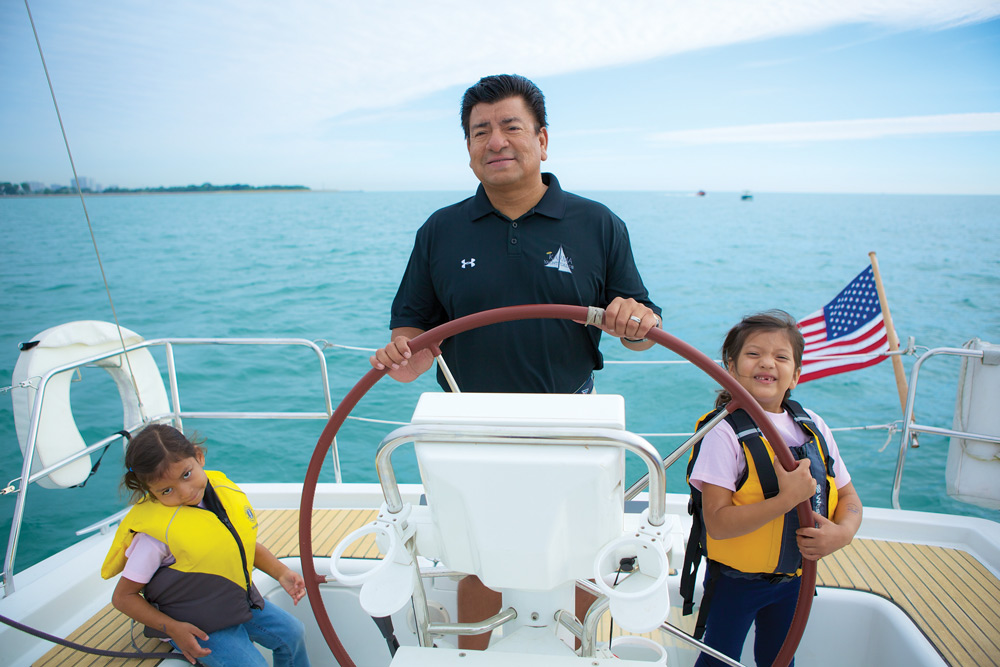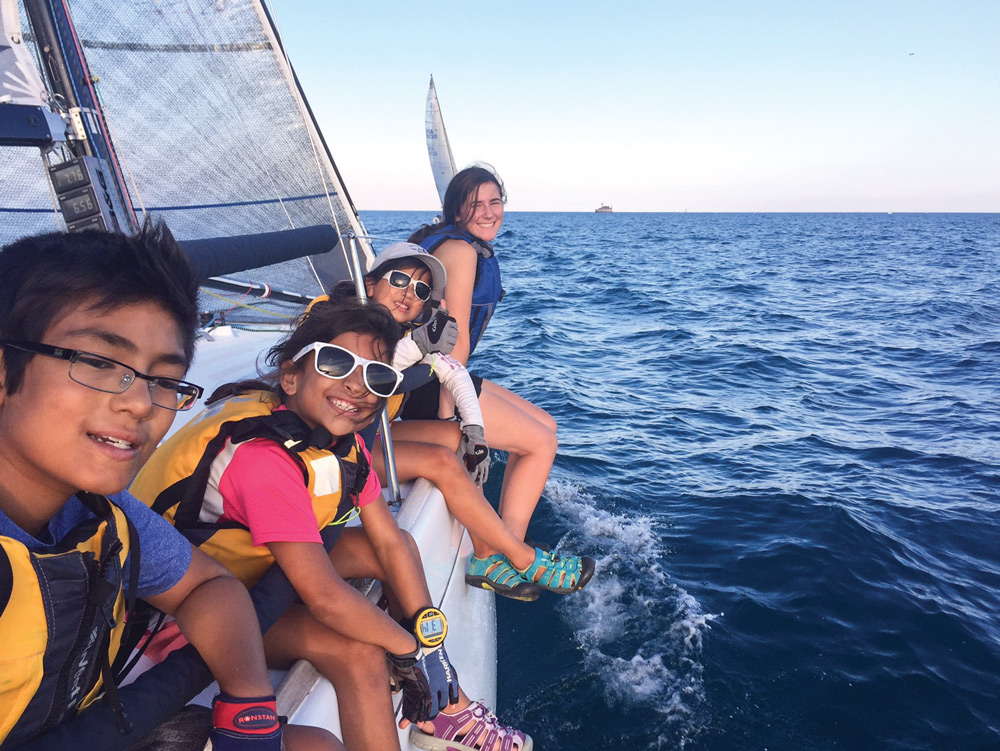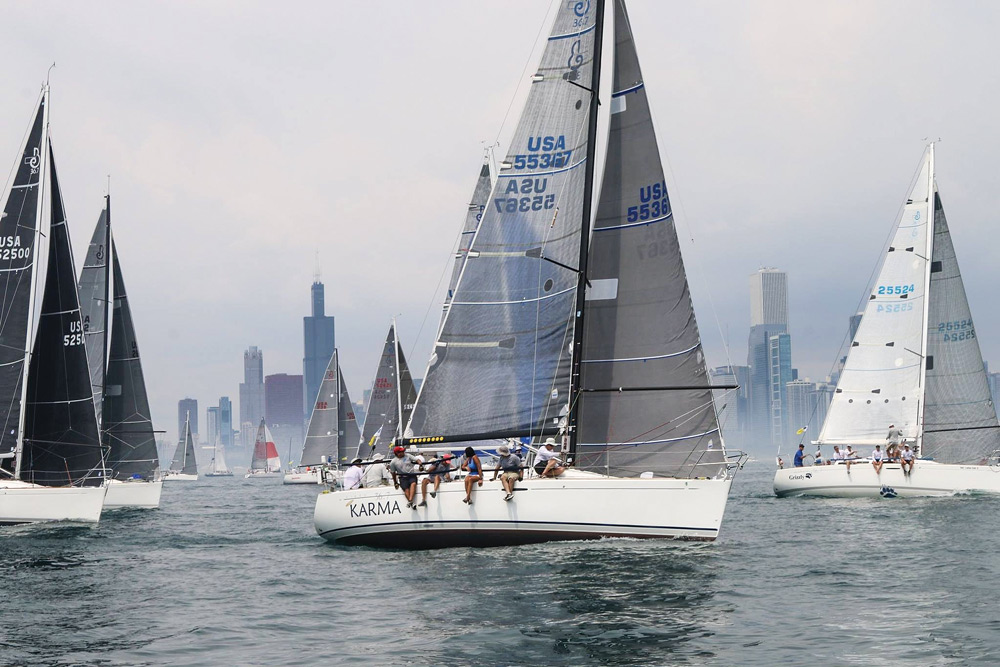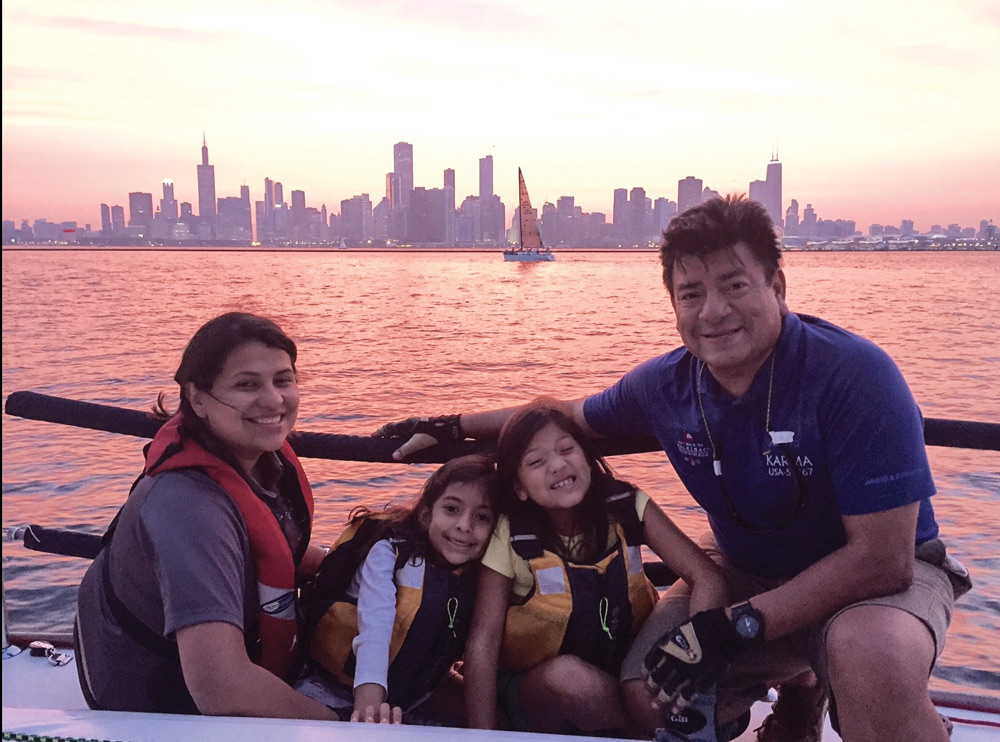A circuitous route to the sailing life
This Chicago man didn’t grow up sailing, but it became a passion he’s passing on to his family
Like a sailboat, life never moves in a straight line from the starting line to the finish. It also has a tendency to blast you with roaring winds, strange currents and a startling array of unexpected circumstances, which means you’ll learn a heck of a lot along the way—and very likely emerge stronger and wiser than before.
No one understands that better than Lou Sandoval, whose love of sailing has taken his life in directions he never expected and forms the backbone of everything from his profession to his family life.

Sandoval didn’t grow up in a sailing family. Far from it. His paternal grandparents were migrant workers; they regularly traveled from their farm in Mexico to farms in the United States that needed help. As a result, Sandoval’s father and his seven brothers and sisters were born in communities across North America.
“My father was born near Minnetonka, Minnesota,” he says. “After his parents died, he came to live in Chicago with his oldest brother, and he got a job in the steel mills at age 18.”
The elder Sandoval worked in the mills for more than 40 years, providing a solid working-class upbringing for his own four children, who he and his wife enrolled in private Catholic schools.
“They made sure we got a good education,” Sandoval says. “It was a good foundation for all of us, and we grew up with strong family values.”
The first in many twists of fate came in the form of the Cub Scouts. A friend invited an 8-year-old Sandoval to attend a meeting, and he was intrigued by what he discovered.
“They did so many fun outdoor things, like camping and hiking,” he recalls. “When I was 10, I went to a scouts’ summer camp in Michigan, near Muskegon. That’s where I started sailing. I earned a merit badge sailing Sunfish.”
Sandoval’s childhood experiences at the Owasippe Scout Reservation’s Big Blue Lake shed entirely new light on his home. Although it sat in the shadow of the steel mills on Chicago’s South Side, it was just two blocks from Lake Michigan.
“So many Chicago kids live near the lake, yet they never go there,” he muses. “That’s a challenge for our city, because the water can give young people so many opportunities.”
That certainly was true for him, although it wasn’t obvious at the time. He continued to enjoy sailing on his way to earning the rank of Eagle Scout, but he set his sights elsewhere.
“I loved sailing, along with playing football and ice hockey, which was somewhat atypical for someone of my background,” Sandoval says with a laugh. “I also became interested in medicine.
“I decided I wanted to be a physician,” he continues. “Scouting, in a way, was like career development. It reinforced my foundational values and character, it challenged me to seek out new opportunities, and it taught me that it was OK to explore and learn different things. I focused on the science merit badges, and when I went to college, I majored in biochemistry and was pre-med.”
Sandoval earned his Bachelor of Science degree from DePaul University in 1988 and started his thesis while working in an interim research position at Chicagoland’s Loyola University Medical Center. Then he realized he had a problem. Despite years of aspiring to become a doctor, he felt drawn to the biotech/biomedical industry instead.

When a management position came his way, his business career took off. Sandoval would spend 17 years in the biotech world, earning three management certificates in busienss from Northwestern University’ in the process.
After a couple of years traveling to different countries for six-month stints in each place, he relocated to Seattle. He says he knew little about the Pacific Northwest prior to calling it home, but it had a couple of positives going for it.
“I knew it had mountains, and that was good, because I like to ski,” Sandoval recalls. “And it had the ocean, which was a prerequisite for a kid who grew up on the lake.”
As he settled into his new life, he got to know a number of physicians who owned boats but didn’t have time to maintain them. Sandoval spotted an opportunity to develop a business, and to reignite a passion.
“For awhile, I worked north of Chicago, and I knew people who sailed out of Waukegan Harbor,” he explains. “That was my re-entry into the sport, as I was away from it post-scouting. So, when I moved out West, I got involved at the Corinthian Yacht Club of Seattle and realized I could build a side business.”
Sandoval attracted six valuable clients who needed him to manage their 38- to 55-foot boats so they’d be ready to go out at a moment’s notice. Some of these clients were racers, and Sandoval soon secured a crew spot on the Victoria to Maui International Yacht Race.
The Vic-Maui is the West Coast’s longest offshore sailing race and a gem in the crown of Pacific Northwest ocean racing. The bug bit hard, according to Sandoval, who went on to complete several Newport to Cabo Races and two Transpacific Yacht Races.
“The Transpac is phenomenal,” Sandoval marvels. “To leave Los Angeles and sail in the trade winds until you see Diamond Head… and me, just a kid from the South Side of Chicago.”
Next, Sandoval’s career took him to Miami, where he continued sailing and racing, becoming regular crew in the Southern Ocean Racing Conference. He’d sold his side business to a subcontractor, but his reputation followed him, and the boat business proved difficult to shake off.
“I started getting calls to see if I could set something up in South Florida,” Sandoval says. “One guy in particular was really persistent. Before I knew it, I had seven clients.”
He was back in the boat-management business, and he continued to pursue long-distance ocean racing, from the Newport Bermuda Race to the off-the-record Havana Cup. In the latter, sailors cast off from St. Petersburg and set sail for Cuba, where they would round a buoy off Havana Harbor before making the return trip.
“It was kind of a bootleg race,” Sandoval says. “It was all about the thrill and adventure. That’s me. I love hiking, biking, mountain climbing—when I was in Seattle, I climbed Mount Ranier. That comes from my scouting experience, that need to be outdoors and have adventures.”
Eventually, Sandoval came back home to Chicago, where his brother and a friend were co-owners of a Catalina Capri 18. They decided to join forces with another friend to purchase a 27-foot 1978 AMF Paceship.
“We nicknamed it Chiquita, because it looked like a banana, and it had a Brady Bunch interior,” Sandoval says, laughing. “I joined the Chicago Yacht Club, and in that first year, four bachelor guys logged 52 days of sailing. We raced it, too. Then we looked at this depreciating asset and thought, why don’t we sell it and use that money to make a down payment on a new boat?”
The partners purchased a 2000 Beneteau First 36.7 that they named Karma, and, they participated in their first Chicago Yacht Club Race to Mackinac.

“That really got us going,” he says.
It was about to get even more intense. Sandoval had befriended the couple who owned local Beneteau dealership Darfin Yachts; they were ready to get out of the business but didn’t have a succession plan in place.
“I’d gone from Abbott to Bristol-Myers Squibb to a small biotech company, and all of a sudden, here was this completely different opportunity,” Sandoval says. “Between 2000 and 2002, I bought the dealership with a partner and renamed it Karma Yacht Sales.”
The dealership sold the Beneteau brand for many years, before finally parting ways in 2016. Sandoval’s longtime partner also moved on, leaving him at the helm. It was admittedly a challenging time for the award-winning business, and for Sandoval.
“There’s no linear path to success,” he reflects. “The path is filled with up and downs. I can deal with that, because I’m persistent, resilient and definitely not a linear thinker. Few people can make a pastime into a living, and it’s not always rosy. But it’s what I signed up for.”
Sandoval’s ability to handle challenges and adjust to rapidly changing situations served him well when, after nearly several years serving on the Chicago Yacht Club Race to Mackinac committee, he became chairperson for the 2012 Mac, the year after two sailors died during the race when the high-performance WingNuts capsized and turned turtle in 70-knot winds.
“That was traumatic,” he says. “It was the first time in the 103-year history of the race that people died doing what we all love so much. I thought, well, this is the path chosen for me. Something like this tests your character and puts you into action; I had to continue on, develop a game plan, and get the event back on track.”
He was successful. Participation boomed the following year, and the processes he and his team developed are still in place today.
Sandoval remains active in CYC leadership. He served as rear commodore for two years, and then he was voted into the position of vice commodore, the person responsible for the club’s physical assets—including a fleet of more than 100 boats—and its junior sailing program.
“If I continue on this path, I just might become the first person of my background, from a working-class family, to become commodore,” he says. “That would be something.”
Sandoval is intensely committed to his work, and to the marine industry. For him, that mission has two key components: improving accessibility, and fostering inclusivity.
“Our industry is so insular,” he says. “There’s a whole generation that hasn’t grown up on boats. We need to figure out how they can come to sailing later in life.”
The starting line scares people, Sandoval says, so the industry has to combat the perception that sailing is difficult.
“We pulled together the five major yacht clubs in our area and said, look, what we’re doing isn’t working,” he explains. “We understand that we need to change the way our sport is perceived, so we created the ‘Casual Race Series,’ a yearlong venture that has a wonderful sail-your-home mentality. It doesn’t matter if you have a big Bimini top or a barbecue grill hanging off the back. Just come out, race, be with your friends and family, and have fun.”
According to Sandoval, it’s up to Gen Xers now. The Baby Boomers had their cottages, campers and boats, which got family members spending time together and making lifelong memories through outdoor recreation. Gen-X has to step up and make quality family time a priority, he said.
“Boats are perfect for that, because you have to interact and be fully present,” he says. “My kids—now 8 and 10—have been on boats since they were 6 months and a toddler.”

When it was time for CYC to hire a lead sailing school instructor, Sandoval said he was keen to hire a qualified woman, for the sake of the many little girls in the program and for his own daughters, who started sailing Optis as 6-year-olds.
“They need to be able to see themselves in her,” he says.
That speaks to the second part of his personal mission.
“Diversity isn’t the right word,” Sandoval says thoughtfully. “Inclusivity is much better. We need to be inclusive, especially when it comes to sailors with disabilities. It’s such a gift to spend time on the water, and everyone should be able to do it.”
Sandoval’s commitment to these principles extends beyond his personal life and CYC. He serves on several industry boards, working with organizations such as the Recreational Boating and Fishing Foundation, Sail America and the Recreational Boating Leadership Council.
Through it all, he keeps adjusting his sails and moving ever forward.
“What I learned from sailing is that you’ll always find breeze, but there are so many different ways to get to your destination,” he muses. “You’re always tacking, always adjusting. In a way, my story is a classic sailing tale.”

Comments